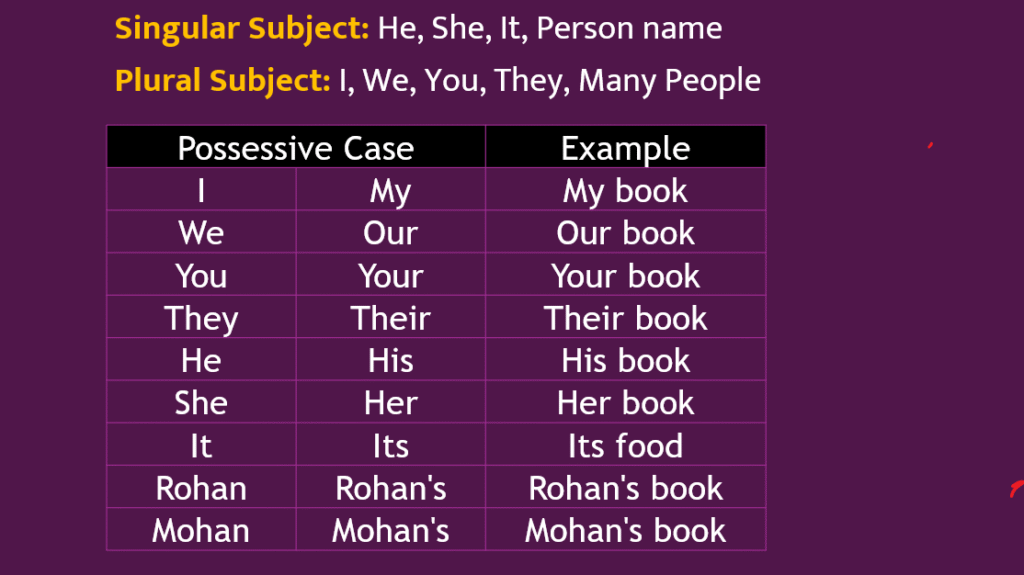
Possessive Case (स्वामित्व बताने वाला रूप)
Possessive Case का प्रयोग तब किया जाता है जब हमें बताना हो कि कोई वस्तु, व्यक्ति, या चीज़ किसी की है। इसे मुख्य रूप से दो तरीकों से व्यक्त किया जाता है।
1️⃣ Apostrophe ( 's ) का प्रयोग
जब हम स्वामित्व (ownership) दिखाना चाहते हैं, तो हम अक्सर किसी संज्ञा (noun) के बाद 's लगाते हैं।
📌 Examples:
Manoj's father - मनोज के पिताजी
Rohan's book - रोहन की किताब
Mohan's pen - मोहन का पेन
Teacher's desk - अध्यापक की मेज
🔹 यदि कोई संज्ञा बहुवचन (plural) हो और पहले से ही s पर समाप्त होती हो, तो केवल ' (apostrophe) जोड़ते हैं।
The students' classroom - छात्रों की कक्षा
The teachers' meeting - अध्यापकों की बैठक
2️⃣ "of" का प्रयोग
स्वामित्व दिखाने का दूसरा तरीका है "of" का प्रयोग, जिसमें object और owner के बीच "of" लगाया जाता है।
📌 Examples:
Father of Manoj = Manoj's father - मनोज के पिताजी
Book of Rohan = Rohan's book - रोहन की किताब
Name of the teacher = Teacher's name - अध्यापक का नाम
The house of my uncle = My uncle's house - मेरे चाचा का घर
🔹 कब कौन सा प्रयोग करें?
✅ लोगों और जानवरों के लिए 's का प्रयोग ज्यादा स्वाभाविक है।
Manoj’s father ✔ बेहतर
❌ Father of Manoj (दैनिक बातचीत में कम प्रयोग होता है)
✅ निर्जीव चीज़ों के लिए "of" का प्रयोग ज्यादा किया जाता है।
The cover of the book ✔ बेहतर
❌ The book’s cover (कम प्रयोग होता है)
3️⃣ Possessive Pronouns और Adjectives
कभी-कभी हम 's या "of" के बजाय possessive adjectives का प्रयोग करते हैं।
📌 Examples:
My book - मेरी किताब
Our school - हमारा स्कूल
Your pen - तुम्हारा पेन
Their house - उनका घर
His bag - उसका बैग (लड़का)
Her dress - उसकी ड्रेस (लड़की)
Its tail - उसकी पूंछ (जानवर/निर्जीव)
Possessive Table
| Serial No | Hindi | English | Possessive Case | Example |
|---|---|---|---|---|
| 1 | वह | He | his | उसकी किताब (his book) |
| 2 | वह | She | her | उसकी किताब (her book) |
| 3 | यह | It | its | इसका खाना (its food) |
| 4 | रोहन | Rohan | Rohan's | रोहन की किताब (Rohan's book) |
| 5 | मोहन | Mohan | Mohan's | मोहन की किताब (Mohan's book) |
| 6 | मैं | I | my | मेरी किताब (my book) |
| 7 | हम | We | our | हमारी किताब (our book) |
| 8 | आप | You | your | तुम्हारी किताब (your book) |
| 9 | वे | They | their | उनकी किताब (their book) |